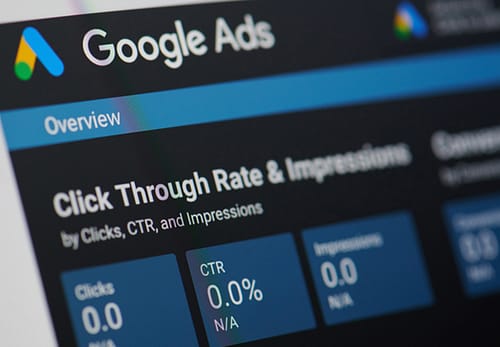Are you a construction group or an independent architect? Have you tried using Google Ads Marketing to generate leads but failed to generate good results? Follow this checklist to run successful Google Adwords Marketing campaigns and generate a high number of leads for your architecture business.
Checklist for setting up Google Ads Marketing
-
Keyword Research-
Keywords play the most important role in driving profitable results from Google Ads. Use keywords that are most relevant to your business, its services, or the problems your prospect is trying to solve. If you use an agency, you need to keep up with these keyword trends because how users search for your goods and services is continuously evolving.
To increase volume or improve efficiency, your Google Ads account specialist management should regularly look for fresh keyword growth prospects.
Example –
If you use the keyword ‘Office architects’ for Google ads and have nothing related to the same keyword on your website, the performance of your ad campaigns is likely to be affected. Your ad won’t produce cost-effective results as Google won’t show your ad at a competitive price.
2. Competitive Research
Any PPC optimisation approach should include a stage for competitive keyword research. It is simple to decide which keywords to target for your client by researching the target keywords of your competitors (and which ones you should not).
#1 Identify your closest top competitors.
#2 Analyse their marketing and keyword strategies.
#3 Evaluate the gap in their strategies and use it to your advantage.
3. Single Keyword Ad Groups (SKAGs) & Single Theme Ad Groups
Single Keyword Ad Groups do just what their name implies—they make one ad group for each keyword. Although you may track the effectiveness of each keyword and target your adverts more effectively, this could be readily misused.
For starters, you should only employ this strategy when the volume of searches and conversions justifies the added work. Second, avoid creating competing SKAGs that the Google algorithm would interpret as close variants.
However, if you’re not attentive, you wind up spending hours playing negative keyword Whack-a-Mole since you have to continually check your search terms report to make sure you aren’t overpaying for useless keywords.
4. Create a Negative Keyword List
Using negative keywords may tell Google which search terms you don’t want your advertisement to appear for. Depending on the match type, adding a negative keyword to your campaign instructs Google to hide your ad for any search term that contains that keyword (phrase match, exact match, broad match).
For instance, you might avoid using phrases like “affordable” or “cheap” if you only sell luxurious yarn. You can do this by placing a minus sign in front of phrases, such as “cheap” or “deal,” for which you don’t want to appear.
With this feature, you can customise locations, distinguish yourself from your competitors, and filter out low-intent keywords.
5. Remarketing Lists for Search Ads (RLSAs)
When users perform a Google search, RLSAs target them with tailored advertisements. Given that these people already have a personal connection to your brand and are actively looking for a solution to a current problem, this can be a very effective strategy to contact your target demographic and enhance the performance of your PPC marketing campaign. Consider the following when using RLSAs.
- You’ll need a long enough remarketing list for RLSAs to be effective.
- Your ad copy and landing pages must be specially designed to the mindset of returning users.
- Optimise your bid adjustments for prospects who are more likely to convert.
- Consistently monitor your results and improvise your Google Ads.
6. Understanding Keyword Search Intent
There are two broad aspects of your search intent.
1) Search Intent Type – Is the seeker looking for information, commerce, or navigation?
2) Search Intent Match – Does the search intent fit your client’s offering? Just because you have a high-volume keyword doesn’t mean people are necessarily looking for your product or service when they search that word.
You’ll do a better job of producing content that satisfies their demands and advances their objectives if you know what a potential consumer seeks out when they search for a specific key phrase.
7. Target Your Best-Performing Locations
You can target specific areas using geographic targeting in Google Ads or change your bids based on areas that respond favourably (or unfavourably) to your message.
You can target continents or nations or, more specifically, by choosing specific regions, cities, or even postal codes. It makes your PPC marketing more effective. For instance, change your bids and targeting if visitors in London react more favourably to your commercial architecture sunscreen ads than those in Birmingham.
8. Target Your Ideal Demographics
If you have a good understanding of the target market, utilise this knowledge to include or exclude specific demographics or use bid modifications to prioritise stronger versus weaker targets.
Historical data from the Google ad campaign sometimes supports or contradicts your target audience’s personal information. You should compare that knowledge with that data. Age, gender and audiences are typical components of the population.
For instance, if a business provides elderly residences, it’s highly likely the 18–24 demo will underperform. The 55-64 age group converts fairly effectively, especially during the holidays.
9. Use all available Ad Extensions.
One of the best aspects of Google Ads Marketing is ad extensions. You cannot afford to leave them unfilled because, on average, adding just one additional ad extension increases CTR by 10% to 15%.
The challenge is determining when, why, and where to utilise them. Google Ad Extensions essentially accomplish what their name suggests: they lengthen your ad by including extra useful information for customers. They are free to use, which makes them even better. The benefits are:
- Increased click-through rates
- A large amount of customer data
- Enhanced Ad Ranks
10. Timely Test Dynamic & Responsive Ads
Google has excelled in one area over the past few years: using responsive and dynamic capabilities. There are more options than ever to allow Google’s AI to adapt to the market, whether it be through dynamic search advertisements, remarketing retail ads, or responsive text ads.
But not everything that glitters is gold. Therefore it’s crucial to test these digital marketing strategies with each business and their respective industry. You might discover that responsive text advertising succeeds with one business but fail with another.
11. Set Conversion Settings & Tags
Make sure you verify and apply the proper settings to each type of conversion if you’re utilising Google Ads conversion settings. Review the following conversion settings for the best results:
- Conversions Count
- Conversion Window
- Attribution Model
Use Google’s data-driven attribution modelling if your account has enough conversion data. It analyses account history to provide credit for conversions depending on how consumers interact with various advertisements before becoming leads or customers. Develop a unique model for that account. It examines the total effectiveness of the keywords, advertising, and campaigns for that account.
12. Always Test your Ads & PPC settings.
Always be testing. With Google Ads Marketing, there are numerous opportunities for testing and revision. At all times, your agency should be doing at least one big test. Just be mindful to avoid testing too many things at once because the outcomes could get muddled.
Testing can be as easy as introducing new ad variations or landing pages. It could be more sophisticated, like calculating the ROI if all the CPCs in a campaign were cut by 20% or certain regions were eliminated.
13. Cautious Bid Adjustments
Bid adjustments are an excellent approach to alter your accounts based on a variety of variables, like geography, time of day, day of the week, demographics, etc., rather than merely omitting some lower-performing parts.
However, we’ve frequently witnessed accounts manage bid revisions poorly, often with devastating outcomes. It’s crucial to keep in mind that bid adjustments stack. Thus the final outcome can be exponential.
14. Send traffic to the correct landing page
The most common practice followed by companies is to direct the traffic to their homepage. But if you are targeting a keyword for a particular service, you should redirect the traffic to your service page.
You can also create landing pages for the keywords you target with Google Adwords.
Example –
Target Keywords – London Architect, Architects in London
Create a Landing Page – www.abc.com/london-architect
15. Monitor Lost Impressions
The alternative of leaving your money on the table is a lost impression share. Your search budget or your bid are the two most frequent reasons you’ll miss out on some searching eyes.
- Budget-related lost impression share simply indicates that the funds were depleted earlier than expected.
- Lost impression share owing to bid indicates that your advertisements didn’t appear since they were outbid in the auction; instead, their rivals’ ads appeared.
- Lost impression share due to rank indicates that the chance for improvement at the same budget exists. Even modest changes like revising copy to increase relevance can have a big impact.
16. Make Google Understand Your Audience
When setting up your ad in Google Adwords, ensure you are sending the right instruction to Google on how to process your keywords for targeting. Try using the following 3 techniques –
Use square brackets ‘[ ]’ (Exact match)
If your keyword is Architects in London, using square brackets, like [Architects in London] will inform Google to show your ad for only the search queries that have the exact same phrase.
Use quotation marks ‘ ” ” ‘ (Phrase match).
Writing your keyword between the quotation marks as “Architects in London” will direct Google to target search queries having the same keyphrase in the same order with other words on any side of it.
Use the word on its own (Broad Match).
Writing the keywords with no symbols allows you to explore all associated words relating to this topic. Be warned this needs to be tightly controlled through negative keywords, budget and cost per click. Otherwise, you could find a poor-quality of leads.
17. Analysis of seasonal patterns
We’ve far too frequently observed marketing companies panic when account performance begins to decline and then go into overdrive with optimization. But close examination of seasonal trends frequently reveals that this specific time of year has always been a low point for the customer.
Your agency will be able to prevent needless optimization that can wind up detracting from the long-term performance by understanding the typical and relevant seasonal trends.
18. Strategise with Statistically Significant Data
Peaks and troughs are common and similar to the seasonal problem mentioned above. Agencies may launch A/B testing or other optimisation initiatives as soon as they observe favourable (or unfavourable) results. But when more data comes in, we all know these findings aren’t necessarily accurate.
Use a statistical significance calculator to ensure that the test has received sufficient traffic and conversions. This way, your google ADs marketing strategy is based on numbers.
19. Determine the Value of Search Partners
When it comes to employing Google Search Partners, there is a complex solution. They can offer a lot of lower-cost traffic, on the one hand. The traffic they generate, however, is often of inferior quality.
For instance, employing Google Search Partners is a wise choice if you have a high-performing campaign, such as a brand or remarketing campaign, and you want to increase exposure.
20. Channel Your Budget where you get the best ROI.
Ensure you are concentrating the expenditure on the areas where it generates the best ROI rather than cutting budgets or keyword bids uniformly.
Your top-performing keywords should be included in top campaigns or ad groups. Any remaining funds can be used to evaluate and maximize additional opportunities.
Quechua Digital Advisory – Boost Your Architect Business
We are the most renowned social media marketing agency in London for professional service organizations. You can trust us to generate a significant amount of leads for your architect’s business. Quechua Digital Advisory is a team of excellent Google Ads Marketing strategists who can help you achieve better ROI from your Google Ads Marketing Campaigns.
From finding the perfect keywords for your business to placing your ads in the best manner, our experts can do everything that is required to run outstanding Google Ads.
If you are into a commercial or residential architecture business, an independent architect, or a construction company, Quechua Digital Advisory can scale your business to new heights by producing more leads through Google Ads Marketing.
Please see the business return we created for a South London Architect here.




















